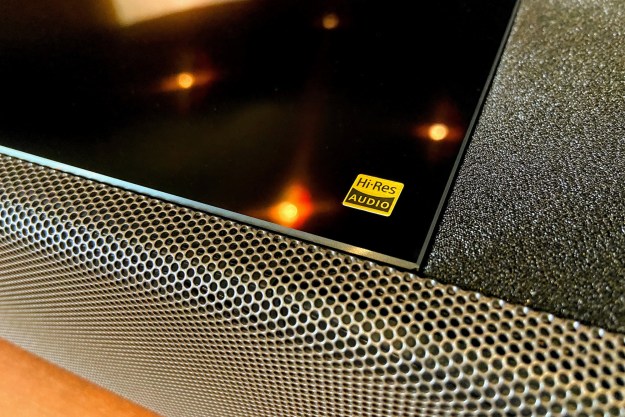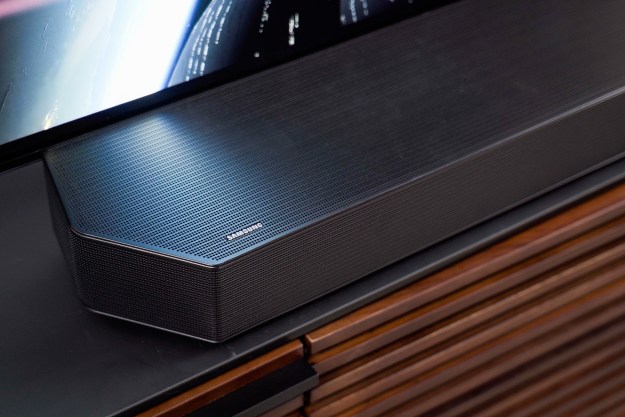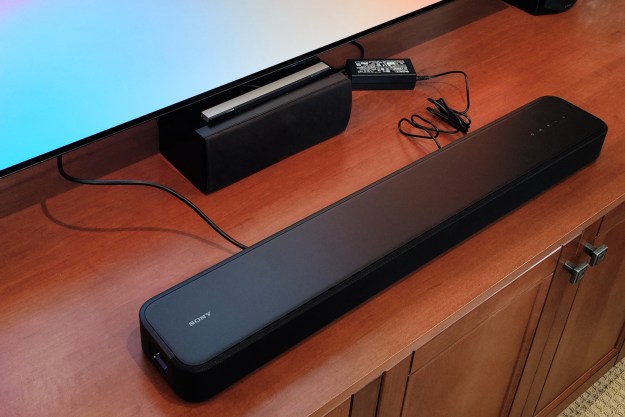
- Very convincing virtual Dolby Atmos
- Commanding bass for single speaker
- Easy set up
- Optional wireless sub and surrounds
- No Wi-Fi or ethernet
- No AirPlay 2, Chromecast, or voice AI
Sony’s latest compact soundbar, the HT-S2000, is by all appearances designed to compete directly with the Bose Smart Soundbar 600 and the Sonos Beam Gen 2. At $500, it’s the same price as the Bose and only $50 more than the Sonos. All three share similar dimensions and feature five drivers in varying sizes and configurations. None come with subwoofers or surround speakers but each can be upgraded with these components later if you wish.
Critically, for those who want to enjoy the immersive experience of spatial audio music and soundtracks, all three support Dolby Atmos, with Sony going the extra mile by adding the less common DTS:X format as well.
But there’s one area where the HT-S2000 diverges quite dramatically from the competition: It has no wired or wireless network connection and no smart speaker or multiroom capabilities. That not only means you can’t use it to access Amazon Alexa or Google Assistant, but it also removes the option of using technologies like Chromecast or AirPlay 2, which offer substantially better streaming audio quality than Bluetooth. A lack of network support can also affect app control performance, which I’ll discuss in a moment.
It’s a Sony
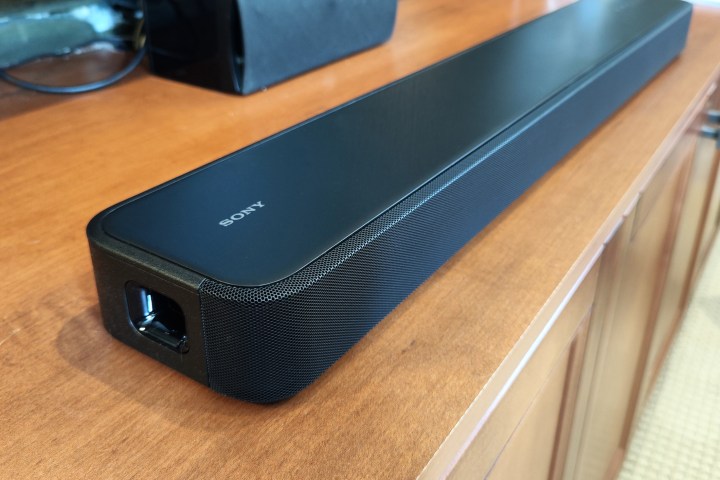
Product design isn’t the only area where Sony, Bose, and Sonos take notes from each other. Sony’s packaging now follows Sonos’ lead — there’s no plastic at all save for the two reusable locking lugs at the ends of the box. Even the included AAA batteries for the remote control are free from the terrible shrink wrap that has been standard for eons.
Inside the box, you’ll find the HT-S2000, a remote, the batteries, an HDMI cable, a power supply, and a wall-mount template.

Speaking of the power supply — and forgive me for nitpicking — Bose and Sonos integrate theirs into the bodies of their speakers. Sony does this on its larger soundbars like the HT-A5000 and A7000, but for the S2000, there’s a brick that will need to be hidden. For folks with media cabinets, this should be an easy thing to do, but I’m less convinced that those who wall-mount their soundbars will be able to make things look neat and tidy.
The HT-S2000 itself is typical Sony — a long black rectangle with pleasingly rounded corners and a metal grille that wraps around those corners. It doesn’t draw attention to itself, and at 31 inches wide and a hair over 2.5 inches tall, it might just fit between the legs of your TV. If it can’t — and if the soundbar blocks the lowest portion of your TV’s frame — you can enable the built-in infrared repeater to help pass along your TV remote’s signals.
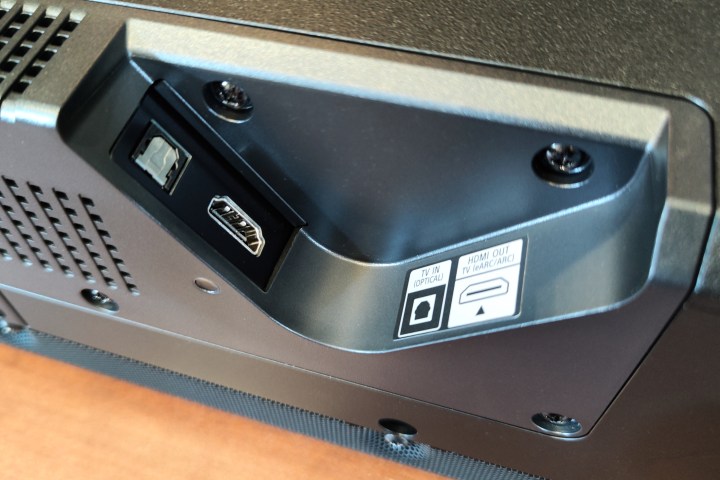
The connections on the back panel are as bare-bones as it gets. HDMI-ARC/eARC, optical, and a USB port for local music playback (in theory — I’ll explain). That’s it. Sadly, the optical and HDMI ports can’t be used for different devices as they’re both for TV audio.
Normally, this is the part where I bang on my cage like an angry gorilla and criticize Sony for not including at least one more HDMI port to offset the one that will be used to connect the soundbar to the TV, but I would be wasting my breath. The industry has spoken and, apparently, you simply can’t get multiple HDMI ports at this price.
Hidden behind the grille is the same scrolling alphanumeric OLED display that Sony uses on its other soundbars. I like to see my current volume level displayed as a number, or see a text-based confirmation of my current input — that’s an itch the Bose and Sonos bars simply don’t scratch.
Easy setup, quirky app
Like its competitors, the HT-S2000 is incredibly simple to set up, if for no other reason than you basically only have two steps: Decide if you want to connect the soundbar to your TV via the included HDMI cable or an optical cable that you’ll need to purchase separately, and then plug the bar into a power outlet. There is a companion app for smartphones (iOS/Android), which you’ll want to get, but it’s not a must-have. The included remote and the soundbar’s touch controls are all you need to get going.
Unlike Sony’s HT-A series soundbars, which use the Sony Music Center companion app, the HT-S2000 uses a different app called Home Entertainment Connect. (iOS | Android) Once you fire it up, you can connect to the S2000 over Bluetooth. This happens automatically once you give the app permission to use Bluetooth to find nearby devices. It’s this Bluetooth connection that can prove troublesome — several times when I checked the app to make an adjustment, the app’s info wasn’t in sync with the soundbar, or it told me I was no longer connected. Restarting the app always seemed to fix it, but it was a nuisance.

Before you can use the app, you will have to agree to a fairly lengthy terms of service agreement. I didn’t see anything in there that I haven’t seen on hundreds of similar agreements. But if any of it gives you pause, it’s worth repeating that you do not need the app for basic operation.
You’ll be asked if you want to set up any of the compatible Sony wireless speakers, and after that step, you’ll be shown the main settings screen for the S2000. It’s very straightforward, with options to switch from TV to Bluetooth, toggles for night mode (reduced dynamic range), voice mode (enhanced dialog), and sound field (Sony’s virtual surround sound processing). You can also control the volume, mute, and the bass boost level.
- 1. Rear USB port.
- 2. Infrared repeater.
- 3. Keyhole slot for wall-mounting.
Those are the controls that are just as easy to do using the remote. It’s the deeper settings that are worth diving into, but here’s a pro tip: use Sony’s web-based help guide. It’s the actual owner’s manual that should have been printed and put in the box but isn’t. It will guide you through things like changing the sound field mode, enabling the USB port for playback, and even connecting the S2000 to your TV via Bluetooth should you want to go wireless.
For Dolby Atmos fans, the app also serves one very critical function. It indicates when the S2000 is processing a true Atmos signal from your TV. Strangely, Sony’s A-Series can show Atmos status using the front display, but the S2000 doesn’t.
Superior cinematic sound
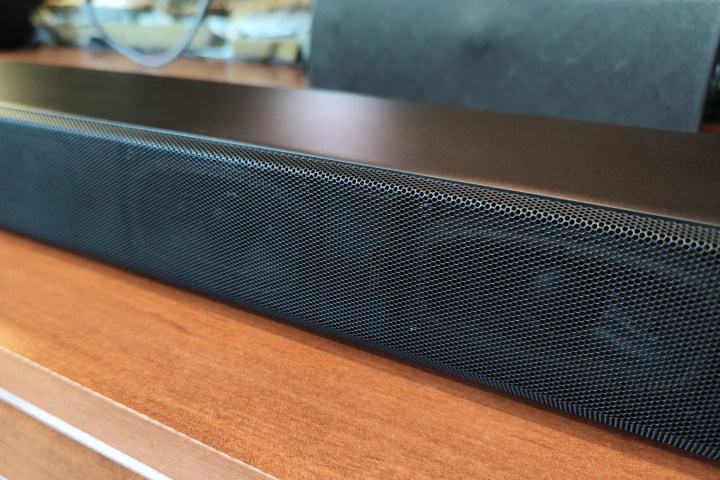
Speaking of Atmos, let’s talk about the sound quality. When running at 70% or higher volume level, the HT-S2000 is a shockingly good speaker for Dolby Atmos. Like its more expensive older sibling, the $700 HT-A3000, the S2000 virtualizes its Atmos signal, which means it uses some very clever digital signal processing to mimic surround and ceiling speakers with just its five forward-facing drivers. And just like the A3000, the S2000 performs this digital trickery with such precision that it beats out the Bose Smart Soundbar 600 when it comes to immersion — even though the Bose has a pair of dedicated, up-firing drivers for height effects. As for the Sonos Beam Gen 2? It’s no contest, the S2000 wins hands-down.
It’s not quite as clear for dialog as the Smart Soundbar 600 (dialog has always been a notable Bose strength) but neither is the difference stark enough to let it worry you — it will still be miles better than your TV. Voices are very well-centered and sound as though they’re coming from the TV, not the speaker — something I’ve noticed is a hallmark of many Atmos soundbars.

As with most compact soundbars, the bass won’t shake the furniture, and you may well want to buy one of Sony’s wireless subs to give you that extra oomph. But I was impressed at just how much low-end the two internal subwoofers provide. Again, you’ll notice it most when you crank up the volume, but there’s more than enough rumble to give high-octane action movies that edge-of-your-seat feeling.
One of my favorite test scenes for audio, in general, is the moment in No Time To Die when James Bond’s Aston Martin is riddled with bullets from automatic weapons while he and his companion are forced to endure the sound of bulletproof glass being systematically weakened one shot at a time. Outside the car, the gunfire sounds like a series of high-pitched cracks that come from no particular direction. Inside the car, we hear these shots as deeper thuds as the bullets impact metal and glass — and they’re clearly coming from specific locations. The S2000 has enough low-end to let you feel each impact, while the speaker’s virtual height and surround channels offer a very convincing sense of the confined space of the car’s interior.
At these moments, the higher frequencies can be a bit overbearing. I found myself wishing for the bass and treble controls that exist on the Beam Gen 2 and Bose 600, but for some reason, Sony doesn’t offer any EQ adjustments save for the amount of bass boost. For Sony, this seems to be an ideological rather than a financial decision — none of its home theater soundbars have EQ control.
You can also thoroughly enjoy Dolby Atmos Music via the S2000 if you’re using the right devices. In my case, this was an Apple TV 4K running the Apple Music, Amazon Music, and Tidal apps. The same virtualization works really well, and yes, I still found myself wanting to adjust the EQ a bit to get things dialed in.
Unfortunately, if you don’t want to run streaming music via your TV, you’re stuck with Bluetooth audio for phone-based streaming. Disappointingly, Sony hasn’t included its own LDAC hi-res Bluetooth codec, so Android and iPhone users alike will be limited to AAC.
Don’t get me wrong, as a Bluetooth speaker the HT-S2000 still sounds pretty terrific. You can choose to hear standard two-channel stereo or you can once again engage Sony’s sound field to give your non-spatial music a much more immersive quality. I like it so much, I just left it turned on. I’m just disappointed because I know it could sound even better with lossless audio over Wi-Fi via AirPlay 2 or Chromecast.
You could also use the built-in USB port to play music from an attached hard drive, but it’s like Sony really doesn’t want you to use it. The port isn’t enabled as a source by default — you must enable it in the Home Entertainment Connect app. You can only play .WAV audio files (which no one uses because they’re huge). All of your music must be located in the root directory of your external hard drive or flash drive — folder contents will be ignored. There is no way to select a specific track or even get the S2000 to play the tracks sequentially; shuffle mode is always on. Finally, unless you’re using the app, there’s no way to play/pause or skip forward/back. Yes, it’s terrible and I can’t recommend it at all.
With the HT-S2000, Sony has opted to put all of its eggs in the sound quality basket instead of competing with similarly priced soundbars that have extra features. From a Dolby Atmos perspective (for both movies and music), that was definitely the right call. A soundbar is first and foremost about improving your TV’s audio quality and the HT-S2000 is fantastic for that. Frankly, if that’s what you care about most, it’s refreshing to know that you’re not paying for extras that don’t contribute to this mission.
But its lack of Wi-Fi or wired networking means it will be forever locked out of some convenient and desirable features like lossless music streaming, multiroom audio, and smart home connectivity. If you’re good with that tradeoff, the HT-S2000 is a brilliant audio upgrade.
Editors' Recommendations
- Sony’s best soundbars are reborn as the Bravia Theater Bar 8, Bar 9, and Quad
- TCL goes all-in on Dolby Atmos with its first 7.1.4-channel soundbar
- How to buy a soundbar: from size to subwoofers, which is the best for you?
- Bose’s new flagship Dolby Atmos soundbar brings AI smarts to the dialogue problem
- Sennheiser’s Ambeo Soundbar Mini is a pricey, bedroom-sized Dolby Atmos speaker

















